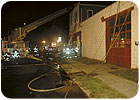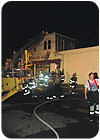When Disaster Strikes the Disaster Restoration Company

Most of us working in the disaster restoration industry switch to an objective, business-minded way of thinking when tragedy strikes, and we empathize with the victims of fire, flood, or other disaster. But what happens when the victim is you?
I was working at my part-time job as an emergency medical technician in Glassboro, N.J. I was sitting in the station completing my paperwork when, at approximately 10 p.m., I heard a dispatch for the fire department the next town over for a working, multi-unit, multi-alarm commercial building fire.
It was the commercial building where my office and warehouse is located.
I rocketed out of my chair, grabbed my partner, and we were off to the scene. I was certain it was my office on fire. Two minutes later we had actually beat most of the fire department – and their apparatus – to the scene. As we arrived we could see flames shooting 40 feet into the air out of the top of the building. With the fire raging I thought I was going to watch my livelihood go up in smoke (fortunately for the company and me, the main conflagration was on the other side of the building, away from my office).
I can’t even begin to describe what I was feeling. I was instantly transformed from rescuer to victim of disaster. I watched as my friends and co-workers in the department battled the fire, and got it under control one unit away from my building. Only one person was slightly injured in the blaze. Major tragedy was averted, and I breathed a sigh of relief. The fire was officially out at 4 a.m., and in the end we suffered only soot and water damage. I was fortunate that the utilities, other than our city sewer and water, were intact.
Our day crew was in at 8 a.m., the first order of the day being to board up the other side of the building. After getting my teams out the door I began the process of cleaning up my own office; all the while the phone kept ringing and we continued booking new disaster projects uninterrupted. We were extremely fortunate; 16 hours later we were back to a pre-loss condition, except for a lack of water.

Some tips to help avert a disaster:
Have a plan in place. Always have a backup location; plan one close to your operation and another far from your existing location. An associate of mine had a disaster restoration business located in New Orleans pre-Katrina. Once he saw things were going to get bad, he packed out his equipment, moved 130 miles north and set up a temporary base of operations.
Plan for communications. During the events of 9/11, we were 80 miles from New York City. Phone lines, both land and cell, were clogged. We routed calls to an associate’s office about 300 miles away, and used them to coordinate our operations. E-mail and instant messaging worked to help establish communications. Companies operating regularly in remote areas or in extreme situations should consider purchasing or leasing satellite-based phones.
Back up data. Find a company that has servers away from your geographic area and make sure they have a backup. Scan your files so you have electronic copies available.
Review your insurance policy. Know what is and is not covered on your policy, and look for ways to minimize exposure.
Establish relationships. Establish contacts with rental companies and other disaster restoration companies. In the event of a total loss, you will have resources to call on to help get you back on your feet.
Choose your facility carefully. Choose buildings that are on high ground if you live in a flood-prone area. Modern buildings are more likely to have fire suppression and better firewalls. If you are considering a multi-unit building, check the adjoining business and evaluate their risk for disaster.
Hopefully, you will never experience a situation like this, but everyone working in this business knows – obviously – that disaster happens. But remember, in times of disaster, positive thinking and positive efforts will do wonders in seeing you through the loss.
Looking for a reprint of this article?
From high-res PDFs to custom plaques, order your copy today!






